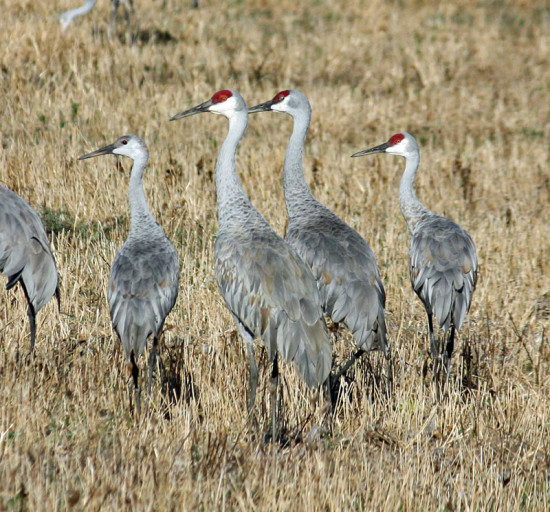GORE BAY – To a farmer it is an all too common sight, a vision straight out of a Alfred Hitchcock horror film—hundreds of Sandhill cranes forming up in regimented lines to march across the cornfields, stripping the rows clean with an efficiency that would make any general proud. But there may soon be relief on the way thanks to an innovative experiment taking place on the Martin farms in Manitoulin’s West End.
Farmers Nicolas and Alex Martin were exhibiting their family’s fields during the 2021 AgroMart Manitoulin Farm Tour when they discussed progress on the Avipel biopesticide application trials currently in their second year.
“Mom (Birgit Martin) has been part of the Avipel program for two years,” said Nicolas Martin. He pointed out that the Martin family has three cornfields currently in the program, two with the Avipel application and one on the Seventh Line as a control.
Mr. Martin explained that the Avipel application lasts for about three weeks (Arkion Life Sciences, the company that makes Avipel, notes the bird repellant biodegrades in about 28 days). “The cranes might settle in a field one day, but after they get a stomach ache from the stuff and they smell it, they move on.”
“Avipel is the first scientifically proven seed treatment to stop birds—from blackbirds, crows and grackles to pheasants, Sandhill cranes, starlings and more—from eating newly-planted corn seed,” reads the company website. “Made from an organic chemical found in plants, Avipel is a nonlethal, nontoxic and nonsystemic corn seed treatment that can lead to greater corn crop yields, raising growers’ bottom lines.”
Mr. Martin described seeing “three or four hundred cranes” descend on a field. “They strip it off in a hurry. Cranes are really intelligent birds,” he continued. “Where Canada geese can’t seem to find a row and just wander about, the cranes zero in on the rows and follow them across the field. They just line up along the rows.” The result can be a complete devastation of that year’s crops.
“(The Sandhill cranes) have also learned to pull the shoot out of the ground, step on the shoot with their foot and eat the soft seed,” he said, preventing any chance of a new shoot popping up after the cranes have moved on.
The issue regarding Sandhill cranes is largely a Northern Ontario one, noted Mr. Martin, pointing out that in the south there are literally hundreds of thousands of acres of corn being planted each season. “They can maybe absorb the loss a bit better,” he suggested. While there are likely not more than 2,000 acres of corn planted in the entire North. It is a factor that probably explains why Avipel had not yet been approved for general use.
The results of the trials have so far been positive, in Mr. Martin’s estimation, with the two fields with treated seeds having little impact from Sandhill crane depravations. Even the untreated field has been less impacted this year, but still enough to show results.
“It’s important to have the untreated fields for comparison,” said Mr. Martin.
Avipel’s active ingredient is 9,10-anthraquinone (AQ), explains the company website, “an organic chemical found in a number of plant species, including aloe vera, rhubarb, greater plantains and sennas. While being a particularly effective agent for repelling birds, AQ is non-lethal to them.”
Avipel is a biopesticide that is ultraviolet light-stable, biodegrades with a 28-day half-life in soil, features very low soil mobility and is insoluble in water—all important considerations for a land stewardship conscious farmer.
The corn crop this year looks to be very good, notes Mr. Martin as he stands beside stalks that tower above his head. In part thanks to Avipel, and the timely intervention of rainfall, the corn had a chance to get well established.





